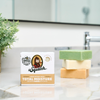
What’s Really in Your Products? | How to Read Product Labels
Do you know what’s really in your grooming products? How to read product labels and understand ingredients
Why is it Important to Read Product Labels?
Even when you try to be careful about what types of grooming products you use, it’s hard to know what you’re actually buying. Something may look natural from the packaging, but actually be filled with harsh synthetic chemicals. It’s difficult to know how to read product labels and even if you do give it a try, they can be confusing and intimidating.
So to help you stay informed, in this post we help you learn how to read product labels and decode ingredient lists so that you can make better, more informed choices about the grooming products you use. With some basic knowledge you’ll be able to understand what’s in your products in no time (no chemistry degree needed).
How is the Ingredient List Organized?
First of all, it’s helpful to know that there are regulations about how ingredients lists are put together. Don’t worry, we’ll explain the method to the madness.
The first step in learning how to read product labels is understanding how they’re organized and why. In the United States, the Food and Drug Administration (FDA) regulates the personal care industry and determines these requirements. They separate personal care products into two main categories: cosmetics and drugs.
These categories have slightly different labeling requirements.
What are the Labeling Requirements for Products?
For products that fall into the cosmetics category, the ingredient list is several lines of text on the back of a product package, ordered by weight. For example, if water is the first ingredient in a list, then it means that water is the highest percentage ingredient making up that formula. Then the ingredient after water is the second most used ingredient, and so on.
A caveat to this rule is that ingredients making up below 1% of a product formula can be listed in any order. This is why preservatives or colorants are often listed last, or close to last, since they’re used at very low concentrations.
Are Drug Facts Labeling Requirements Different?
If a product is making a specific drug claim with an FDA approved active drug ingredient, then it’s considered an over-the-counter drug and the label needs to follow even more specific FDA labeling requirements.
Here are a few key callouts about Drug Facts label requirements:
- Active ingredient: this is the ingredient that makes the product an over-the-counter drug.
- Uses and warnings: The “active ingredient” determines the uses and warnings – this part of the label is identical for all products using the specific active ingredient.
- Inactive ingredients: These ingredients are everything else that’s included in the product. These are organized by concentration in the formula, just like the ingredients order on cosmetic labels.

Example label from the FDA
How to Understand Ingredients on a Label
There are so many different ingredients with confusing names out there which makes reading the ingredients on a label overwhelming (even if you happen to be armed with some chemistry knowledge). The good news is that we’re here to help you learn how to understand ingredients, without having to memorize every chemical compound in existence.
You’re in luck, cause we have some tips to help you learn how to decode the label. Here’s what we’ll cover:
- Common prefixes and suffixes that are found in ingredient names, which can give you clues as to what an ingredient really is.
- Learn to categorize ingredients based on their key attributes, which will help you to make sense of where an ingredient comes from, and why it’s included in a formula.
- Explained with real-world examples of ingredients in Dr. Squatch products.
Each ingredient can be classified by three main attributes: source, class and function.
1. Source: Where Ingredients Come From
Ingredients can be derived from a variety of sources. Learning the different sources and common naming conventions can help you start to understand where an ingredient came from and if it’s something you actually want to use on your skin.
Natural Sources
If you generally try to use natural products on your skin and want to avoid products with harsh synthetic chemicals (you all should!), you should look for products with ingredients from plant, animal and minimally processed mineral sources. Here’s how you can identify them:
Plant Sources
Ingredients sourced from plants include oils and extracts such as olive oil, coconut oil, aloe vera.

- Dr. Squatch natural soaps are made with plant sources like olive oil, coconut oil, and sustainable palm oil.
- Our beard oil is made with almond oil, argan oil, and jojoba seed oil.
Common naming conventions: ascorb-, -gly*, -lac, laur-, -lipids, myrist-, -ole-, phyto, sorb-, tocopher-
Animal Sources
Examples of common animal sources include beeswax, royal jelly, honey, silk, collagen, carmine, elastin, keratin and tallow
- Many Dr. Squatch products are vegan, but our Eucalyptus Greek Yogurt soap is made with real Greek yogurt.

*In some cases, prefixes can be shared between multiple sources. For example, the prefix gly- can indicate both animal or plant derived ingredients (such as glycerin).
Mineral Sources

Mineral sources include kaolin, clay, copper, mica, iron oxide, titanium dioxide, zinc oxide, salt, pumice.
- Our natural shave bar contains bentonite clay
- Deep Sea Goat’s Milk bar soap contains sea salt
Synthetic Sources to Avoid
Synthetic chemicals typically have sources that require more processing and may come from sources such as petroleum, bio-synthesis and fermentation.
Petroleum
Examples of petroleum sources include carbomer, mineral oil, parabens, petrolatum and vinyl. If you see any of these, you should run for the hills.
Common naming conventions: acetate-, -ene, -eth, isopropyl, PEGs (polyethylene glycol)
2. Class : Traits of Ingredients Based on Chemical Family
Many different classifications of chemicals are used as ingredients in personal care and grooming products. Ingredients within the same class may have different functions, so to understand how a formula works, you need to look at both the class and function (which we’ll cover next).
The three common classes of chemicals are acids, polymers, and alcohols.
Acids
Acids are chemicals with a pH below 7.0. They are added to formulas for a variety of functions ranging from adjusting the pH to the acne-treating properties of salicylic acid.
- Naturally occurring examples: citric acid, glycolic acid, stearic acid, hyaluronic acid, salicylic acid
- Dr. Squatch natural shampoo and conditioner both contain citric acid, which helps smooth the hair cuticle and also acts as a natural way to preserve the formula (more on preservatives later).
Common naming convention: -ic acid

Polymers
Polymers are large molecules formed by many repeating structural units. Some occur naturally, but most are synthetically produced. Polymer groups include gums, proteins, polysaccharides, and silicones.

- Natural examples: xanthan gum, guar gum, carrageenan, cellulose and cornstarch.
- Xanthan gum, a natural polymer that comes from plants like corn, is used in Dr. Squatch natural shampoo and conditioner.
- Synthetic examples to avoid: carbomers or silicones like cyclopentasiloxane.
Alcohols
Alcohols are chemicals that have a hydrogen and an oxygen molecule attached to a carbon molecule. You may vaguely remember learning this in school. It’s referred to as an hydroxyl group, written as -OH.
- Natural examples: menthol, stearyl alcohol
- Cooling menthol, which can be sourced naturally from peppermint oil, is an example of a natural alcohol that’s used in Dr. Squatch conditioner.

- Other examples (can be either natural or synthetic, depending on source): tocopherol, propylene, glycol, ethanol
Common naming conventions: -ol, -yl
3. Function: The Role an Ingredient Plays in the Formula
Understanding the function of a material helps you understand why it’s in the product. Typical functions include: surfactants, stabilizers, and preservatives.
Surfactants
The name “surfactant” comes from the phrase “surface active agent.” Simply put, these are the ingredients that clean you. Surfactant molecules have a hydrophilic (water-loving) head and a hydrophobic (oil-loving) tail. The oil-loving tail attracts oil and dirt and the water-loving head allows dirt, oil and germs to be washed away.
Every soap, body wash or detergent formula uses surfactants, but you should seek out real soap made with natural surfactants, instead of the harsh synthetic surfactants used in traditional body washes.
- Natural examples: cocamidopropyl betaine, coco glucoside, decyl glucoside

- Saponified oils of coconut, sustainable palm oil and olive oil are the natural surfactants used in Dr. Squatch natural soaps.
You may also see these written as: sodium cocoate, sodium olivate, and sodium palmate.
- Synthetic examples to avoid: sodium lauryl sulfate (SLS), sodium laureth sulfate
Stabilizers
Stabilizers are often used to thicken formulas. Gums are a very common form of stabilizer used in various types of products.
- Natural examples: xanthan gum, guar gum, magnesium aluminum silicate
We talked before about xanthan gum as an example of a natural polymer. But now, we’re discussing the function of that ingredient.
Xanthan Gum is a plant-based thickener that is used in Dr. Squatch natural shampoo and conditioner. It’s also frequently found in natural food products!

- Synthetic examples to avoid: carbomer, acrylates copolymer
Preservatives
Preservatives are used to ensure product stability and make a product last longer. They prevent oxidation and bacteria from contaminating a formula.
- Naturally occurring examples: sorbic acid, potassium sorbate, benzyl alcohol*

To limit the use of preservatives in our products, we create water-free formulas like our soaps, beard oils, and colognes.
In cases where preservation is required, like in our hair care products, we choose food grade or naturally-derived options like citric acid, sodium benzoate, and potassium sorbate.
*These are examples of naturally-occurring preservatives, but they can also be manufactured synthetically.
- Synthetic examples to avoid: methylparaben, chlorphenesin, phenoxyethanol, methylisothiazolinone
Sources:
Related Posts
WTF are Plant Butters?
Wed, Jan 22, 2025• Grooming & Personal Care Natural Living & Health
You might be wondering, “WTF are “plant butters”? Is that like vegan “I can’t believe it’s not butter?”. No, but we’re glad you asked. These rich, ...
Read More5 Protips For A Better Shave
Fri, Jan 03, 2025• Grooming & Personal Care
Let’s be real, shaving is a combat sport. I mean you’re dragging a sharp blade across your face on the reg. Nicks, irritation, tight, dry skin afte...
Read MorePucker Up: Lip Care For Men 101
Fri, Dec 20, 2024• Grooming & Personal Care
Let’s face it (see what we did there?)—lip care is for everyone. Whether you're battling the elements, exploring the great outdoors, or just living...
Read MoreHow To Choose the Right Cool Weather Scent
Mon, Dec 16, 2024• Grooming & Personal Care
No matter where you’re at, we deep into the cool and cold weather (well, not you Hawaii) and that means it’s time to evaluate your scent seasonalit...
Read More










Leave a Reply
Your email address will not be published. Required fields are marked *